Outside the capital city of Thimpu, on a Bhutan mountainside, a project is underway to build the tallest si tting Buddha in the world. It will be painted gold. And yet, Buddha doesn’t ask for all of this. He is not a demanding god, but one who points the road down which Buddhist travel in order to reach purity, which is called enlightenment. To them, it goes beyond the physical concept of heaven and requires the cleansing within of all earthy desires and passions. Buddha proclaims “Don’t look at me but to the enlightened state.” Although his image is everywhere in various forms, the legend is the first anthromorphic representation of him was drawn on canvas from rays of golden light emanating from his own body. Although there are various manifestations, there has never been a historically identifiable person. Buddha has not been conceived as a punisher, nor a law maker, but Buddha offers blessings for whomever or wha
tting Buddha in the world. It will be painted gold. And yet, Buddha doesn’t ask for all of this. He is not a demanding god, but one who points the road down which Buddhist travel in order to reach purity, which is called enlightenment. To them, it goes beyond the physical concept of heaven and requires the cleansing within of all earthy desires and passions. Buddha proclaims “Don’t look at me but to the enlightened state.” Although his image is everywhere in various forms, the legend is the first anthromorphic representation of him was drawn on canvas from rays of golden light emanating from his own body. Although there are various manifestations, there has never been a historically identifiable person. Buddha has not been conceived as a punisher, nor a law maker, but Buddha offers blessings for whomever or wha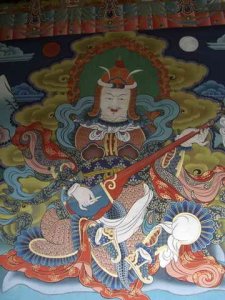 tever enters in his temple (remember, sin shoes.) If you give a gift to a Lama, for instance, he immediately gives it to the Buddha image in his holy room. Buddha owns nothing, and gives away everything, as do his servants. He is a guide to freedom from cravings and desires, to acceptance of a being just being. It’s a difficult humbling in faith which rarely appeals to the Western materialistic society. Being around it in its purest form invited me to clean out my own soul and re-think what we have made of the greatest man ever to walk the earth, Jesus. Do we allow him to be the Light
tever enters in his temple (remember, sin shoes.) If you give a gift to a Lama, for instance, he immediately gives it to the Buddha image in his holy room. Buddha owns nothing, and gives away everything, as do his servants. He is a guide to freedom from cravings and desires, to acceptance of a being just being. It’s a difficult humbling in faith which rarely appeals to the Western materialistic society. Being around it in its purest form invited me to clean out my own soul and re-think what we have made of the greatest man ever to walk the earth, Jesus. Do we allow him to be the Light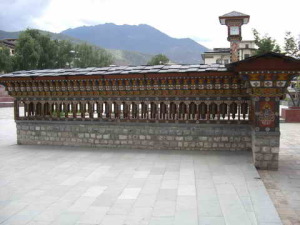 of the World? Even Buddha said, “Be a light unto yourself.”
of the World? Even Buddha said, “Be a light unto yourself.”
The idea of incarnations – so n so is the incarnation of a certain manifestation of Buddha or a previous Dalai Lama or Karmapa – chains Asian religious history. These incarnations are inheritances of lamas who lead the faith much as the Archbishop of Canterbury does Anglicans of the world, and the Pope does for Roman Catholics. They are all representatives of the bigger One God. Hindus, on the other hand, believe what you got is what you got and you can’t get much better or worse no matter what you do, although you should spend your life trying to do bett er and give to the poor, worship cows and snakes, and please don’t forget to take off your shoes at the Shiva temples. The Hindus worship all sorts of versions of Vishnu and othe
er and give to the poor, worship cows and snakes, and please don’t forget to take off your shoes at the Shiva temples. The Hindus worship all sorts of versions of Vishnu and othe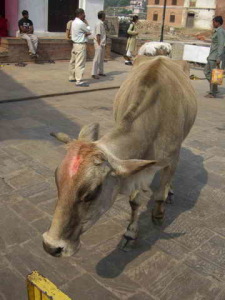 r scarey mixtures of man and animal. And if they really want something, they tie red and gold strings around the holy Boda tree, which, incidentally, is where Buddha was supposed to have been born and snudge red and yellow powders on strolling cattle and monkeys. Markets are packed with now arti
r scarey mixtures of man and animal. And if they really want something, they tie red and gold strings around the holy Boda tree, which, incidentally, is where Buddha was supposed to have been born and snudge red and yellow powders on strolling cattle and monkeys. Markets are packed with now arti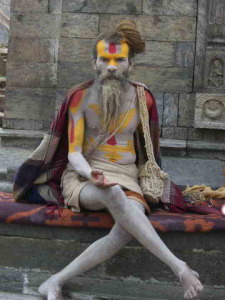 ficial powders, gold and red handkerchiefs for carrying offerings of rice or food, to the temples of their heros and leis of flowers made fresh each morning when the markets open. Non Hindus are not allowed to cross the threshold of sacred temples. Animals wait outside the gates to be the sacrificial “lambs” and of course dead Hindus are cremated on wood piles for all to see at crematoriums edging the muddy Ganges River. Mourners wear white for two weeks.
ficial powders, gold and red handkerchiefs for carrying offerings of rice or food, to the temples of their heros and leis of flowers made fresh each morning when the markets open. Non Hindus are not allowed to cross the threshold of sacred temples. Animals wait outside the gates to be the sacrificial “lambs” and of course dead Hindus are cremated on wood piles for all to see at crematoriums edging the muddy Ganges River. Mourners wear white for two weeks.
In India, it’s in the north where Buddhism is strongest, being on the border with Tibet, because there sits the Dalai Lama and his exiled Tibetan government as well as the young Karmapa representing another of the three Tantric sects. The third incarnated holy figure is the Panchen Lama who, once he was identified, was immediately imprisoned in China even though he was a small child at the time and no one has seen him since. The outcast Tibetans struggle to have back their respect and their territory in Tibet, to be able to return in safety to their historical base from which the Dalai Lama fled for his life during the Mao revolution in 1957 that destroyed so much of China..India gave him refuge in Dharmsala.
In Ladakh and in Dharmsala the presence of Buddhist monks from the youngest to the oldest charms daily life. They appear better off than, for instance, the young monks in Bangkok who early in 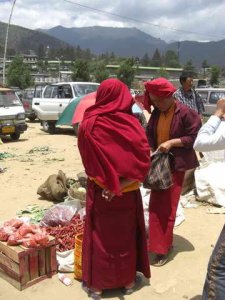 the morning carry their metal bowls around the markets to be filled with food for the day. In Bhutan, especially, Buddhism thrives and monks integrate into the community. There is no obligation for a family to offer a son to be a monk, but the education at monasteries is often superior to public schools. Choosing to follow a monk’s path at an early age does not mean that life is over. Many young men change their mind when they end their teen years and it’s okay, in Bhutan. Monks cannot vote nor get involved with the operations of the state, nor can they express political opinion. But the monk who is the religious leader of all Bhutan has equal the amount of power as the divine King. Both are adored by the people because citizens are taken care of with such charisma. The 28 year old fifth King was preparing for his coronation, since his father the fourth King (this is how they are referred to) stepped down so his son could inherit the throne as the country evolved into a democratic parliamentary system. Bhu
the morning carry their metal bowls around the markets to be filled with food for the day. In Bhutan, especially, Buddhism thrives and monks integrate into the community. There is no obligation for a family to offer a son to be a monk, but the education at monasteries is often superior to public schools. Choosing to follow a monk’s path at an early age does not mean that life is over. Many young men change their mind when they end their teen years and it’s okay, in Bhutan. Monks cannot vote nor get involved with the operations of the state, nor can they express political opinion. But the monk who is the religious leader of all Bhutan has equal the amount of power as the divine King. Both are adored by the people because citizens are taken care of with such charisma. The 28 year old fifth King was preparing for his coronation, since his father the fourth King (this is how they are referred to) stepped down so his son could inherit the throne as the country evolved into a democratic parliamentary system. Bhu tanese had never voted in history. (They evolved from being a warrior nation to being an absolute monarchy in 1907. Bhutan was never colonialized.) The chance to have a say in the running of their country was mesmerizing for voters. Now they worry about how to make democracy succeed. Faith and government may be separated but when the Queen wanted to honor her husband for amazing accomplishments, she built 108 large chortens at the top of a high pass which is also draped in thousands of prayer flags. It’s quite a site.
tanese had never voted in history. (They evolved from being a warrior nation to being an absolute monarchy in 1907. Bhutan was never colonialized.) The chance to have a say in the running of their country was mesmerizing for voters. Now they worry about how to make democracy succeed. Faith and government may be separated but when the Queen wanted to honor her husband for amazing accomplishments, she built 108 large chortens at the top of a high pass which is also draped in thousands of prayer flags. It’s quite a site.
There is a positive spirit in Bhutan, a feeling that less than 700,000 people are happy and content. The king promotes what he calls Gross National Happiness. No more than 20,000 for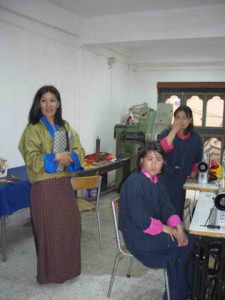 eigners are allowed across Bhutan’s borders in a year. No cigarettes allowed, the sale of tobacco strictly prohibited, even though the fourth king loved Cuban cigars. In certain months, no one can buy anything that must be killed – pork, beef, yak, mutton – so it’s vege
eigners are allowed across Bhutan’s borders in a year. No cigarettes allowed, the sale of tobacco strictly prohibited, even though the fourth king loved Cuban cigars. In certain months, no one can buy anything that must be killed – pork, beef, yak, mutton – so it’s vege tarian time, but every dish is flavored with hot chillis. No outsider can buy land nor even start a business, although if there is a Bhutan partner in the business, that is a possibility. Even foreign artists are not allowed to perform in Bhutan, although fifty per cent of the people are under 25 years of age. Everyone adheres to the national dress code – men wearing knee length skirts, women long ones. The King lives in a modest wooden home in the hills of Thimbu, and he works in an elaborate palace called a Dzong to which various elegant temples are attached.
tarian time, but every dish is flavored with hot chillis. No outsider can buy land nor even start a business, although if there is a Bhutan partner in the business, that is a possibility. Even foreign artists are not allowed to perform in Bhutan, although fifty per cent of the people are under 25 years of age. Everyone adheres to the national dress code – men wearing knee length skirts, women long ones. The King lives in a modest wooden home in the hills of Thimbu, and he works in an elaborate palace called a Dzong to which various elegant temples are attached.
In Bangkok, religious architecture is extreme. I’ve never seen so many different styles of roof tops, mostly pointed spirals and peaks. Gold, silver, colored stone and glass, mosaics and glitter ador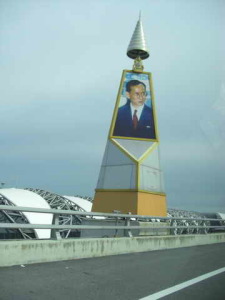 n every religious and palatial structure. The King and his Wife are honored and adored throughout the city on giant banners and billboards, on buildings and streets, spelled out in lights on boats traveling on the busy rivers, and in giant gold frames on divans of principle streets. On Mondays, citizens wear yellow shirts (usually with an embroidered picture of the King where a polo player might be) to honor the fact the King was born on a Monday. On Tuesday, the color is pink and on Thursday, in honor of the Queen’s birthday, it’s blue.
n every religious and palatial structure. The King and his Wife are honored and adored throughout the city on giant banners and billboards, on buildings and streets, spelled out in lights on boats traveling on the busy rivers, and in giant gold frames on divans of principle streets. On Mondays, citizens wear yellow shirts (usually with an embroidered picture of the King where a polo player might be) to honor the fact the King was born on a Monday. On Tuesday, the color is pink and on Thursday, in honor of the Queen’s birthday, it’s blue.
Also in Bangkok, Chinese Buddhist temples so ornate you don’t know what photo to take next add another decorative element to religion. There are huge chortens covered in mosaic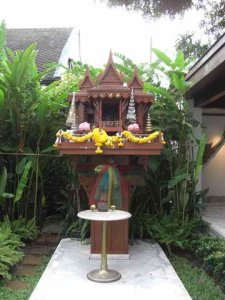 s and dog and monkey men. There are ornate temples housing the reclining gold Buddha (as long as City Hall) or the only standing Buddha in East Asia. There are Buddhas sitting on nagas or snakes, and Buddhas sitting on pillows. There is the elaborate emerald Buddha (really jade) whose seasonal gold clothing the King changes with certain ceremony.
s and dog and monkey men. There are ornate temples housing the reclining gold Buddha (as long as City Hall) or the only standing Buddha in East Asia. There are Buddhas sitting on nagas or snakes, and Buddhas sitting on pillows. There is the elaborate emerald Buddha (really jade) whose seasonal gold clothing the King changes with certain ceremony.
What impressed me most was the presence of Spirit Houses in just about everybody’s yard, in entrances to restaurants, and even in the enormous gardens of the villa in which I stayed.  Because the day I was there was a special day, a huge tray of hom
Because the day I was there was a special day, a huge tray of hom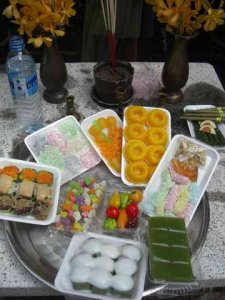 emade sweets, fruits, incense, candles, and jasmine, orchid and rose flowers was placed to appease evil spirits who hopefully roost in these spirit houses and stay out of residences of the faithful. I asked who eats the food. There was sort of a non-answer – so I mentioned birds? Maybe. Or did the evil spirits really reach out their doors and feast. Hmmm.
emade sweets, fruits, incense, candles, and jasmine, orchid and rose flowers was placed to appease evil spirits who hopefully roost in these spirit houses and stay out of residences of the faithful. I asked who eats the food. There was sort of a non-answer – so I mentioned birds? Maybe. Or did the evil spirits really reach out their doors and feast. Hmmm.
Following Faith: Part 2
Photos: site for future tallest standing Buddha in the world; a Thangka of a Budda manifestation; prayer wheels at a Dzong; Non-Hindus not allowed to see the golden bull; holy cow; a Hindu holy man; Bhutan monks at the market; the queen’s 108 stupas to honor her husband; Bhutan friend Sonam with sewing students in national dress; marketeers in national Bhutanese dress; honoring the Thai King; a spirit house; the villa spirit house with offerings; close-up of offerings – all sweets.

Has anyone heard from Audrey since this last post? Getting a tad worried!
She’s fine and back in Memphis!